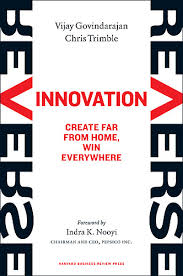Reverse Innovation: Create Far from Home, Win Everywhere

– By Vijay Govindarajan and Chris Trimble
Professor Vijay Govindarajan is one of the leading experts on strategy and innovation. He teaches at the Tuck School of Business at Dartmouth. He was also the first Professor in Residence and Chief Innovation Consultant at General Electric. He worked with GE’s CEO Jeff Immelt to write “How GE is Disrupting Itself”, the HBR article that pioneered the concept of reverse innovation. Having heard Professor Govindarajan twice and having seen his talks over You Tube, I can unequivocally say that he is one of the few management experts who present their ideas simply and clearly.
His latest book – with his regular collaborator Chris Trimble – ‘Reverse Innovation: Create Far from Home, Win Everywhere’ builds on the idea of reverse innovation or trickle – up innovation that he has been talking about for some time now. As many of you may know, reverse innovation refers to an innovation that is likely to be seen, developed or used in the developing world before spreading to the developed economies of the West.
There is no doubt that developing markets like China, India, Brazil, Russia and others are going to outpace the developed world in future economic growth. Products needed in these markets would not necessarily be products that are innovated and used in the developed markets; the high cost of many of these products would be prohibitive for mass usage in the developing markets. For multinational companies – and this book is really addressed to them – the best way to take advantage of the growth in the developing markets would be to develop products suited to these markets and then encourage their usage in the developed markets.
Professors Govindarajan and Trimble argue that businesses that use their expertise and resources to create new, innovative products for the developing economies and then adapt these to satisfy demand in the developed economies are the ones that are going to succeed in the future. And many established, multinational companies have started doing that.
Professors Govindarajan and Trimble have – very succinctly – summarised their key arguments in the book (as the Reverse Innovation Playbook to guide organisations):
Strategy
- To capture growth in emerging markets, you must innovate, not simply export.
- Leverage opportunities to move emerging – market innovations to other parts of the world; to other poor countries, to marginalized markets in rich countries, and, eventually, to mainstream markets in rich countries.
- Keep so-called emerging giants on your radar screen. These small but rapidly growing companies, headquartered in the developing world, have global aspirations that could one day threaten your own.
Global Organization
- Move people, power, and money to where the growth is – the developing world.
- Create a reverse innovation mind-set throughout the corporation. Put the spotlight on emerging markets through the use of expatriate assignments, immersion experiences, corporate events that are held in emerging markets, creative board appointments, and highly visible CEO actions.
- Create separate business scorecards for developing nations with full P&L responsibility and an emphasis on growth metrics.
Project Organization
- Commission local growth teams (LGTs) with full business capabilities for each reverse innovation opportunity. LGTs should act like brand-new companies:
– They must conduct clean-slate needs assessments.
– They must develop clean-slate solutions.
– They must practice clean-slate organizational design.
- Enable LGTs to leverage your company’s global resource base through carefully managed partnerships.
- Manage reverse innovation initiatives as disciplined experiments, with a focus on resolving critical unknowns quickly and inexpensively.
The workbook is meant to encourage big companies to think differently given the fact that they are, obviously, reluctant to let go of the high margin business models that they have been using successfully in the rich countries.
In the second part of the book, the good professors provide examples of the reverse innovation phenomena. For example, in 2002, General Electric, finding it difficult to sell costly ultrasound medical scanners in China, began producing a lower-quality, compact device. They priced it at just 15% of the cost for a traditional ultrasound machine; the product was a hit not just in China but throughout the developing world and in more advanced countries as well.
Another example is how Wal-Mart discovered that its big-box-store formula was not appropriate for Central and South America; shoppers didn’t have enough money or storage space to buy in bulk. The company decided to develop smaller stores selling products in smaller quantities. The same concept is now being used in the dense urban centres of the US.
As I mentioned earlier, the book has more relevance for multinational companies headquartered in the developed world. But it will also prove insightful for Indian executives looking to develop products and solutions that would eventually trickle up.
Rating: A+
